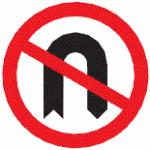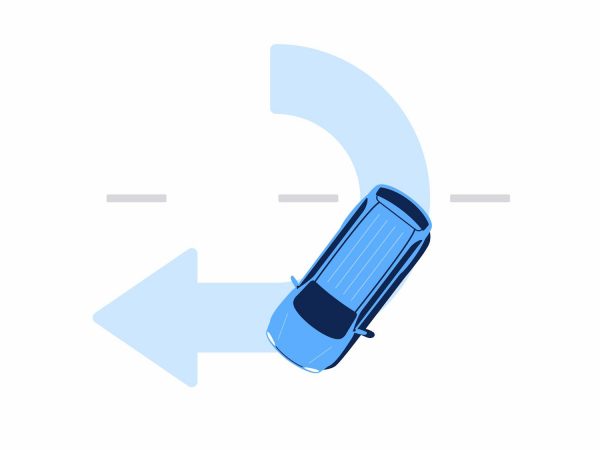A U-turn is where you turn your vehicle through 180 degrees so that you are facing back from where you came. Turning 180 degrees doesn’t include a handbrake turn. A U-turn will either be:
- permitted
- not permitted due to signage
- not permitted due to the road type or road markings
- not permitted due to the type of vehicle
- not recommended due to the vehicle’s size or characteristics.
Let’s deal with the times you can’t do a U-turn first as it’s worth 3 points on your licence and a fine.
Signage

If there’s a no U-turn sign, then you are not permitted to do a U-turn. These are most commonly seen at intersections where doing a U-turn would put you in conflict with traffic either coming towards you from straight ahead, or turning into the carriageway from the right.
It may also be there if there is not enough room for a car to turn safely.
Road type or road markings
You cannot do a U-turn :
- across double white lines in the centre of the road
- across a median strip or where you would have to cross a kerb
- in a one-way street
- on a motorway or dual carriageway
The Highway Code also advises not to do a U-turn at a mini roundabout because other vehicles waiting to enter the roundabout will not expect it and may pull out in front of you, however, it is not illegal to do this.
Type of vehicle
Certain types of vehicles may be permitted at a particular junction whereas others aren’t. This will be shown by a supplementary plate, for example, no U-turn ‘except cyclists’.
Long vehicles are advised to avoid U-turns because of how the rear of the vehicle tracks in relation to the front, and the detrimental effect on the road’s surface due to scrubbing tyres sideways.
Where are you permitted to do a U-turn?
In all other places there is no restriction on doing a U-turn unless it would pose undue risk to other road users. This could be because there’s not enough visibility for approaching vehicles (e.g. just over a blind crest or just after a corner).
Drivers have to consider more vulnerable road users (motorcyclists, cyclists, scooterists, etc).
How do you do a U-turn?

To do a safe U-turn from the left of the road, indicate left and pull over as far left as possible in a position where you can make the turn without mounting the kerb on the other side; if you can’t make it in one move, you will end up having to do a 3-point turn which exposes you to danger for longer. Check your mirrors and signal right. When it’s safe, do a final check over your shoulder in your blind spot and perform the manoeuvre if you have the time. As you straighten up your steering wheel, check your rear-view mirror and side mirrors to check that another vehicle hasn’t appeared while you are doing the manoeuvre and is expecting to overtake.
If you are doing a U-turn at a junction where vehicles can usually turn right, position your vehicle in the left of the right-hand lane to give yourself more room to turn. Be aware of oncoming vehicles or vehicles entering from your right and give way to them.
